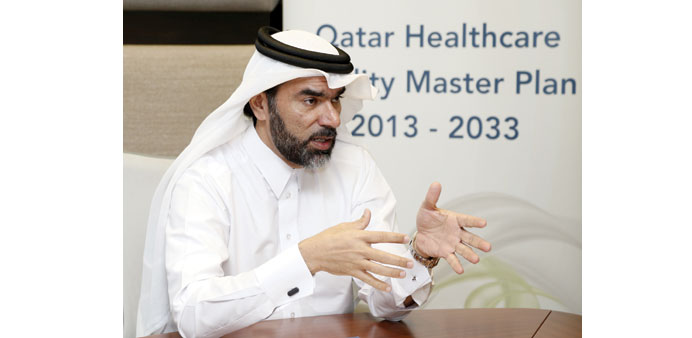Dr Faleh Mohamed Ali: says investing in health infrastructure is a priority for Qatar.
By Joseph Varghese
|
|
As many as 48 healthcare infrastructure projects will be completed by 2020 as part of the Qatar Health Facilities Master Plan (QHFMP) announced yesterday by the Supreme Council of Health (SCH).
The projects include 31 health centres, eight diagnostic and treatment units, a general and specialised hospital each, two long-term facilities and five hospital expansion plans.
Out of these facilities, 14 health centres and eight diagnostic units will be completed within 2016.
The general and special hospitals, two long-term facilities and four hospital expansion plans will be completed during 2015 to 2019. Another hospital expansion will be completed during 2016 and 2020 while 17 more health centres are to be completed within 2018 and 2020.
This will be part of the first action plan adopted for 2013-2018.
SCH clarified that the exact configuration of these facilities may change in order to deliver the necessary services to the public.
QHFMP is a 20-year road map, towards the improvement of the healthcare sector in the country, to be completed by 2033. The comprehensive blue-print, produced as part of the National Health Strategy 2011-2016, outlines how Qatar can support its vision for a world class health system, in new buildings and facilities, through the wise use of its resources.
Making the announcement, Dr Faleh Mohamed Hussain Ali, the assistant secretary general for Policy Affairs, SCH, said: “Investing in health infrastructure is a priority health and social issue as increasing access to services will improve the lives of many individuals and families now and in the future.”
He said: “Developing an infrastructure master plan is essential to guide increasing healthcare capacity and is further evidence that we are 100% committed to making sure that the sector meets the rising demand for quality services and facilities across the state for the next 20 years.”
According to the SCH official, the road map includes a five-year action plan for 2013-2018.
“The QHFMP will ensure that infrastructure spending correlates directly to the needs of the population and the greater model of care,” Dr Ali said.
“Infrastructure is a major driver of annual healthcare costs in Qatar so the master plan will rationalise, integrate and coordinate all existing, planned and proposed facilities.”
Awn Sharif, manager of Health Care Facility Planning, Health Planning & Assessment Department at the SCH, called the QHFMP “the final output from the National Health Strategy (NHS)”.
“The QHFMP is being built on the model of care outlined in the Clinical Services Framework which is closely aligned to 30 of the 39 National Health Strategy Projects which are either influenced by the plan development. Essentially the plan will provide the physical environment to enable the implementation of the NHS.”
“Implicit in the plan is developing a structural backbone to support the NHS priority areas; universal access to healthcare by everyone in Qatar, shifting the balance of care back to primary healthcare and enabling a high degree of specialisation for secondary and tertiary hospital care within Qatar. It may be a plan about buildings and equipment, but the outcomes are focused on enhancing the health of human beings.”
Master plan to involve public, private operators
The Qatar Health Facilities Master Plan (QHFMP) will involve both public and private operators in the healthcare industry. SCH officials pointed out they were hopeful that many leading global healthcare facilities might be interested in opening their facilities in Qatar with the announcement of QHFMP. Officials said that public and private sector healthcare providers would need to apply to the SCH for approval to proceed with the development of a new facility based on financial and service thresholds.

